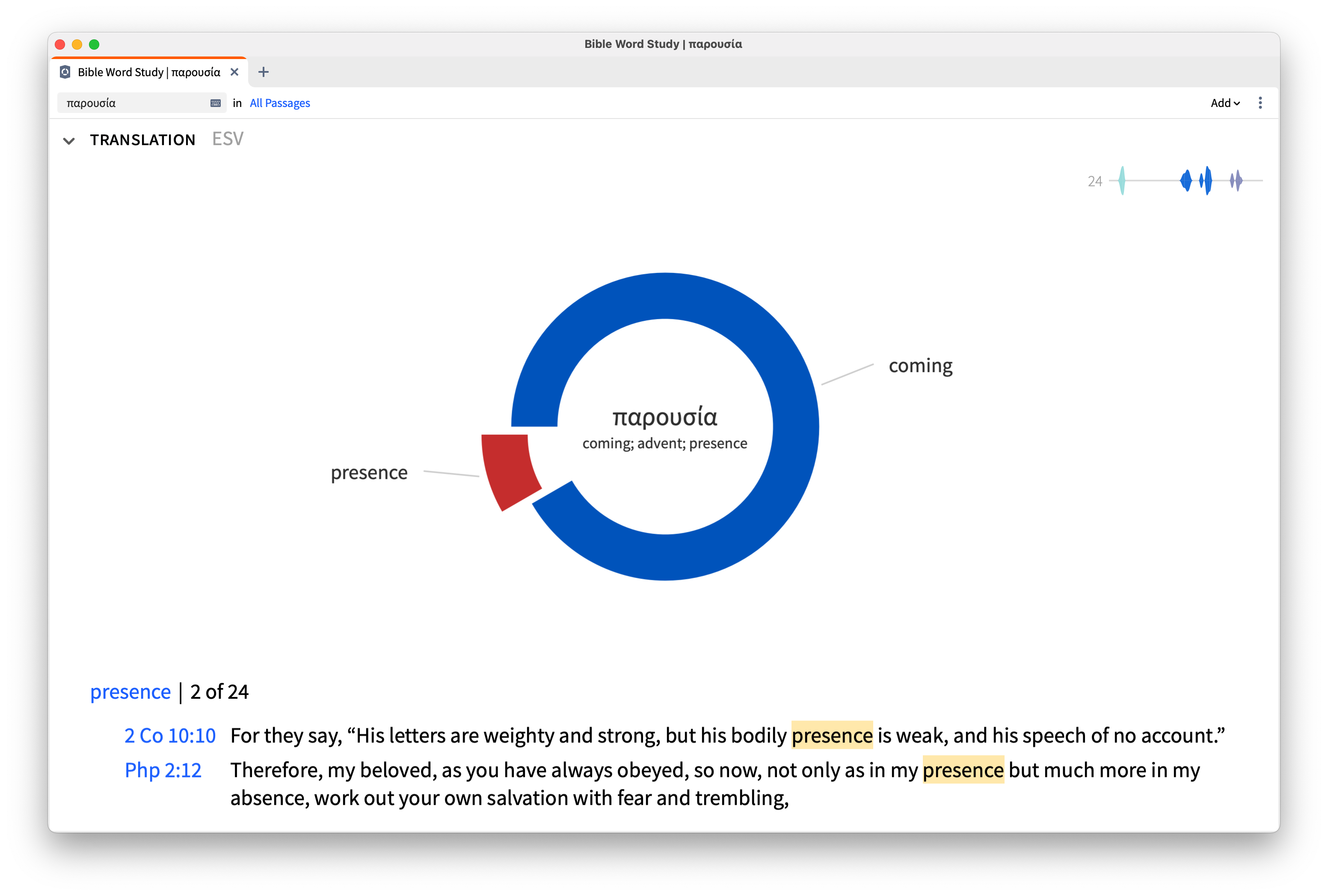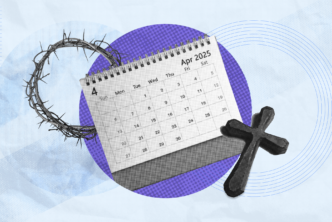From thence he shall come to judge the quick and the dead.
—The Apostles’ Creed
and he shall come again with glory to judge the living and the dead
—The Nicene Creed
From whence he shall come to judge the quick and the dead.
At whose coming all men shall rise again with their bodies
and shall give account for their own works.
—The Athanasian Creed
The creeds confess it because the Bible teaches it: Jesus is coming to judge the living and the dead. What does the New Testament teach about the Parousia?1

Run a Bible Word Study on παρουσια (parousia).
This word can also be used to refer to someone’s “presence,” as when Paul contrasts it with his “absence” (apousia) in Philippians 2:12. It teaches what the Old Testament prophesies, what the Lord Jesus explained during his incarnation before the cross, and the Apostles assert in their writings.
Jesus has ascended to the Father’s right hand, and he will come to save his people through the judgment of their enemies. This article will first look at the Old Testament expectation of the Messiah’s return in Psalm 110 and Daniel 7. From there we will turn to first to the exposition in the epistle to the Hebrews, before turning to the teaching of Jesus, focusing especially on the Olivet Discourse (Matt 24) and what Jesus says to the high priest in Matthew 26:64.2
We will conclude with a survey of the New Testament synthesis articulated by Luke in Acts and by John, Paul, and Peter in their letters.
Table of contents
Old Testament expectation of the Messiah
When we contemplate Psalm 110, we should remember that David fully understands the Pentateuch. This means he understands Adam’s role at creation (Gen 1:28), God’s promises to Abraham (12:1–3), and the prophecies and indications that the Mosaic covenant has failed (Exod 32; Lev 10) and will fail (Lev 26; Deut 4:25–31; 28–32). Though the Mosaic covenant would come to an end, God would keep the promises he made to Abraham, Isaac, and Jacob, and he would keep them by means of the covenant he made with David. As we consider Psalm 110, we bear all this in mind, as well as the fact that David wrote Psalm 110 to complement what he had already communicated in Psalms 2, 8, 18, and 72.
In Psalm 110:1, we find three noteworthy statements:
- First, David gives us an indication that Yahweh addresses David’s Lord (Ps 110:1a), the seed God promised to raise up from his line (2 Sam 7:12–14)
- Second, we read a command from Yahweh telling the future king from David’s line to take his seat at Yahweh’s right hand, enthroned next to Yahweh himself (110:1b).
- Third, Psalm 110 provides a statement indicating that the future king will sit there at Yahweh’s right hand until Yahweh makes his enemies a footstool for his feet (110:1c).
The psalm’s chiastic structure enables us to see how the rest of Psalm 110 elaborates on the initial scene depicted in its first verse. Here is how I outlined this psalm in my Evangelical Biblical Theology Commentary volume:3

This diagram of the chiastic structure of Psalm 110—drawn from Jim Hamilton’s Evangelical Biblical Theology Commentary volumes on the Psalms—was made with the Logos Canvas tool.
The king enthroned at God’s right hand in verse 1 is the victorious warrior refreshing himself by the waters and lifting up his head in verse 7—he needs refreshment because he just fought the battle described in verses 5–6. The authority to reign anticipated in places such as Genesis 1:28, 2 Samuel 7, and Psalm 2:8–9 is granted to the king in verse 2, and he exercises that authority when he goes out to conquer his enemies, executing the authority given to him in verses 5–6. The day of the king’s power is anticipated in verse 3.
In Psalm 110:1, the king was invited to sit at God’s right hand until the day comes for him to fight the battle described in verses 5–6. In Psalm 110:4, the king is installed as the high priest forever according to the order of Melchizedek. As the author of Hebrews points out (Heb 7:11–19), as long as the Mosaic covenant is in effect, Levitical priests from Aaron’s line are alone authorized to serve in that capacity. The declaration of a new eternal priesthood (“forever”) anticipates a new covenant and a new deposit of law (see esp. Heb 7:12).
For the purposes of this discussion, we observe the following: Psalm 110 envisions the future king from David’s line being enthroned in heaven at Yahweh’s right hand as the Melchizedekian high priest forever, which requires a new covenant, and he is specifically told that he will be seated until he conquers his enemies, which conquest is depicted later in the psalm.
In my book, With the Clouds of Heaven: The Book of Daniel in Biblical Theology, I argued for a connection between Daniel 7 and Psalm 110 as follows: the placement of the “thrones” in Daniel 7:9 (upon one of which the Ancient of Days takes his seat), implies that the “one like a son of man,” who receives the everlasting kingdom in 7:13–14, will be seated there with Yahweh. The imagery suggests the enthronement of the one like a son of man alongside the Ancient of Days in accordance with Psalm 110:1. In an important essay, Smith and Vaillancourt make further observations about similarities between Psalm 110 and Daniel 7:
Psalm 110 and Dan 7 both
(1) depict God enthroned (Ps 110:1, Dan 7:9–10),
(2) include a human figure who participates in God’s rule (Ps 110:1–3, 5–7; Dan 7:9–10),
(3) present that figure as simultaneously having kingly and priestly traits (Ps 110:1–2, 4; Dan 7:13–14),
(4) envisage a final, eschatological “day” or “coming,” when God will defeat his enemies and openly manifest his universal rule on earth (Ps 110:3, 5–6; Dan 7:9–10, 14, 22, 26–27), and
(5) assign a central role in that eschatological finale to the human “lord” (Ps 110:1, 3, 5–6) or “son of man” (Dan 7:13–14).
In Israel’s Scriptures, this set of parallels is unique to these two texts.4
Hebrews on the Second Coming
In this brief discussion I can only summarize the essential points of the timeline reflected by the statements made by the author of Hebrews.5
First, the author of Hebrews clearly presents Jesus as the one addressed by Psalm 110:1, who is now seated at God’s right hand: “After making purification for sins, he sat down at the right hand of the Majesty on high” (Heb 1:3). The purification for sins referenced here clearly pertains to what Jesus accomplished through his death, resurrection, and ascension to heaven, where he is now seated at God’s right hand.
Second, even as the author of Hebrews asserts that Jesus is seated at the Father’s right hand in fulfillment of Psalm 110:1b (cf. Heb 1:3, 13), in keeping with the “until” statement of Psalm 110:1c, he also explains, “At present, we do not see everything in subjection to him” (Heb 2:8).
Third, the author of Hebrews explains how Jesus is the high priest forever according to the order of Melchizedek, by whom the new covenant has been inaugurated (5:1–8:13).
Fourth, the author combines quotations of Isaiah 26:20–21 and Habakkuk 2:3–4 in Hebrews 10:37–38, with verse 37 asserting regarding the return of Christ, “Yet a little while and the coming one will come and will not delay.”
Fifth, the author of Hebrews alludes to Daniel 7:13–14 when he speaks of “receiving a kingdom that cannot be shaken” in Hebrews 12:28.
In summary, the author of Hebrews understands Jesus as now seated at the right hand of God (Heb 1:13), waiting until all is subjected to him (Ps 110:1c; Heb 2:8), having inaugurated the new covenant and become the priest according to the order of Melchizedek (Ps 110:4; Heb 5–8). And he is the one who will come (Heb 10:37), at which point his people will receive the kingdom that cannot be shaken (12:28).
Jesus on “this generation”
Largely under the influence of Matthew 24:34—“This generation will not pass away until all these things take place”—people have wondered whether the end would come within a “generation,” that is, within the lifetimes of the group of people alive at the time the words were spoken. The Lord Jesus did not return in his resurrected body to judge the living and the dead within the course of twenty, or even forty, years after his crucifixion and resurrection. Because Jesus predicted the destruction of the temple in Matthew 24:2, some have explained the destruction of the temple in Jerusalem (AD 70) as in some sense fulfilling the expected return within a generation.
Whatever significance may be assigned to the destruction of the temple (AD 70), and it does seem to be at least a fulfillment of Jesus’s prediction in Matthew 24:2, we must nevertheless observe the following: not only did the risen Christ not return in the body, the dead were not raised AD 70, nor did the final judgment take place. If we grant the possibility that the word “generation” (γενεά, genea) might refer to something other than the group of people alive at a particular point in history (more on this shortly), we can account for the numerous indications throughout the Gospels of Matthew and Mark that point to a longer, unspecified period of time between the ascension and return of the risen Lord.6
Consider these indications: when asked why his disciples did not fast, Jesus explained that the “bridegroom,” speaking of himself, would be taken away from them, and then they would fast (Matt 9:14–15). In the parable of the weeds (13:24–30, 36–43), Jesus is both the sower and the reaper (13:37, 41), and “the harvest is the end of the age” (13:39), resulting in the wicked being thrown into the fiery furnace and the righteous enjoying the bodily resurrection in terms reminiscent of the book of Daniel (13:42–43; cf. Dan 12:3). When Judas objects to Mary anointing Jesus at Bethany, saying they could have given to the poor (John 12:4–5; Matt 26:8–9), Jesus explains that they will always have the poor with them, but they will not always have him (26:11). When he institutes the Lord’s Supper, Jesus tells his disciples, “I will not drink again of this fruit of the vine until that day when I drink it with you in my Father’s kingdom” (26:29). All of this outside Matthew 24 indicates that Jesus led his disciples to expect an interval of time in which he was not bodily present with them, even as he also assures them that he will return for judgment and to drink of the fruit of the vine in the kingdom (e.g., John 21:22).
When we turn to Matthew 24 itself, we find that there too Jesus speaks of things that would seem to unfold over a longer period than the mere forty years between his crucifixion circa AD 30 and the destruction of the temple in AD 70. These would include “many” coming in his name claiming to be the Christ (Matt 24:5), nations and kingdoms rising against one another, with famines and earthquakes (24:7), tribulations, martyrdom, the hatred of the nations (24:9), “many” falling away (24:10), false prophets arising (24:11), the gospel going through the whole world (24:14), the abomination of desolation (24:15), and more false Christs and false prophets (24:23–26).
In the midst of all this, Jesus indicates that even as all these tumults and upheavals unfold, “the end is not yet” (24:6); “All these are but the beginning of the birth pains” (24:8); “the one who endures to the end will be saved” (24:13); “and then the end will come” (24:14). We noted above that Jesus predicts the rise of the abomination of desolation in Matthew 24:15, and in Mark’s Gospel the grammar indicates that we should understand this as a man who arises (Mark 13:14; the Greek term “abomination” [βδέλυγμα, bdelugma] is in the neuter gender, which we would expect to be modified by a neuter participle—but instead the participle “standing” is masculine, which would seem to indicate a male human being). Some have suggested that we should understand Nero as the fulfillment of this prophecy, but elsewhere we read that the Lord Jesus will kill this person at his coming (2 Thess 2:8), and that is not how Nero died.
How, then, should we understand the term “generation” in Matthew 24:34? In the near context, Matthew 23:29–36, Jesus pronounces a woe on the scribes and Pharisees in which he calls them a “brood of vipers” (Matt 23:33), which is a colorful way of calling them the seed of the serpent (cf. Gen 3:15). He calls them this after indicting them for identifying themselves as “sons of those who murdered the prophets” (23:32). He then goes on to describe the way they will persecute and kill those whom Jesus will send to them in the future (23:34), with the result that
on you may come all the righteous blood shed on earth, from the blood of righteous Abel to the blood of Zechariah the son of Barachiah, whom you murdered between the sanctuary and the altar. Truly, I say to you, all these things will come upon this generation. (Matt 24:35–36)
Who is the “you” on whom this blood comes, which is to say, who is “this generation”? If we understand it as the group of people alive when Jesus speaks the words, we run up against the fact that he just called that group of people “sons of those who murdered the prophets” (24:31). The “you” upon whom all the blood comes, then, the people referred to by the phrase “this generation,” would seem to include “those who murdered the prophets” across the Old Testament,” the “sons” of those murderers to whom Jesus speaks (24:30–32), and their own descendants who will kill those whom Jesus will send in the future (24:34). Note, too, that Jesus tells this group, “Fill up, then, the measure of your fathers” (24:32), which in view of the context of their rejection and murder and persecution of those who represent God, seems to refer to them filling up the measure of their sins (cf. 1 Thess 2:16). The key to understanding the referent of “this generation” appears to be found in Matthew 23:33, where Jesus addresses them with the words, “You serpents, you brood of vipers, how are you to escape being sentenced to hell?”
It would seem that the phrase “this generation” in Matthew 23:36 must be understood as a particular kind of people; namely, the seed of the serpent who have been at enmity with the seed of the woman since Genesis 3:15. This fits with the way the term “generation” can be used to refer to both the righteous (Ps 24:6) and the wicked (Ps 12:7) in the Psalter (cf. Jer 7:29), and the phrase “this generation” has typological connections with those who fell under God’s wrath at the flood (Gen 7:1) and in the wilderness (Deut 1:35). Further along these lines, on the day of Pentecost, Peter urges his audience to repent and be baptized (Acts 2:38), and he “continued to exhort them, saying, ‘Save yourselves from this crooked generation’” (2:40). Paul, likewise, called the Philippians to be “without blemish in the midst of a crooked and twisted generation” (Phil 2:15).
What happens if we slot “the seed of the serpent” in for “this generation” in Matthew 24:34? The idea communicated would be that the seed of the serpent will not pass away, until all these things take place. This would explain the ongoing persecution Jesus describes his people facing throughout Matthew 24 until his coming. It would align with his statements about how when he returns he will judge the righteous and the wicked. And it would fit with the way that elsewhere the return of Christ results in the resurrection of the dead and the end of the age.
A brief word on Matthew 26:64: When the high priest adjures Jesus to reveal whether he is the Christ, Jesus asserts, “You have said so. But I tell you, from now on you will see the Son of Man seated at the right hand of Power and coming on the clouds of heaven.” In this statement the words of Jesus promise the fulfillment of what we saw above, both from Old Testament expectation in Psalm 110 and Daniel 7 and from the author of Hebrews. Jesus indicates that he will ascend to heaven to be seated at the Father’s right hand in fulfillment of Psalm 110:1, where he will wait until the time that he comes to defeat all his enemies as depicted in Psalm 110:2–7. At that point, he will come with the clouds of heaven, in keeping with Daniel’s vision in Daniel 7:13–14, to receive the kingdom that cannot be shaken (Dan 7:14; Heb 12:26–28).
The apostles on the future
The expectation that Daniel 7:13–14 will be fulfilled when Jesus returns with the clouds of heaven receives confirmation in Acts 1:9–11, where Jesus ascends and “a cloud took him out of their sight” (Acts 1:9), after which two heavenly messengers tell them, “This Jesus, who was taken up from you into heaven, will come in the same way as you saw him go into heaven” (Acts 1:11).
The coming of Jesus results in the resurrection of the people of Jesus (1 Cor 15:21–23; 1 Thess 4:14–16), and thus the people of Jesus are those who are eagerly waiting for him (1 Cor 1:7; Phil 3:20; 1 Thess 1:10; 2 Tim 4:8; Titus 2:13; Heb 9:28). The anticipation Christians feel results from the promise that at his coming, Jesus will judge their enemies and finally deliver his persecuted people from those who have oppressed, persecuted, murdered, and plundered them (2 Thess 1:5–12; Heb 10:32–34). The Lord Jesus will kill the antichrist at his coming (2 Thess 2:1, 8; cf. 1 John 2:18).
Those who expect to be delivered at the coming of the Lord Jesus are also urged to live so that they can be confident rather than ashamed when he comes (1 John 2:28; 1 Tim 6:14; 2 Tim 4:1). Paul speaks of believers, for whom he has suffered and resisted Satan, as his joy, crown, and boast at the coming of Christ (1 Thess 2:19), and he prays that they will be blameless and holy when Christ comes (3:13; 5:23). He tells the Colossians that when the Lord Christ appears, they too will appear with him in glory (Col 3:4), apparently because the dead will be given resurrected bodies (1 Cor 15:21–23) and all will be transformed (15:51–54; Phil 3:20–21; 1 John 3:2). Christ will also reward those faithful to him at his coming (1 Pet 5:4; 2 Tim 4:8).
Wait for it
James urges those to whom he writes to be patient “until the coming of the Lord,” instructing them to consider the way farmers plant their seed and wait for the harvest, telling them to establish their hearts, “for the coming of the Lord is at hand” (Jas 5:7–8). Peter likewise encourages his audience not to be discouraged by the scoffers who “will say, ‘Where is the promise of his coming?’” (2 Pet 3:4). He explains that just as the flood came, so the Lord will come with a “day of judgment and destruction of the ungodly” (3:5–7; cf. the likening of the end to the flood in Matt 24:36–39). Peter notes that the Lord does not reckon time as we do but wants all to come to repentance (3:8–9). The day will come like a thief, and the world will be made new (3:10).
Jesus is coming back. The dead will be raised. The wicked will be judged and the righteous rewarded. “If it seems slow, wait for it; it will surely come; it will not delay” (Hab 2:4; cf. Heb 10:37).
Recommended resources
With the Clouds of Heaven: The Book of Daniel in Biblical Theology (New Studies in Biblical Theology, vol. 32 | NSBT)
Regular price: $19.99
The Royal Priest: Psalm 110 in Biblical Theology (New Studies in Biblical Theology | NSBT)
Regular price: $19.99
The Parousia: A Critical Inquiry into the New Testament Doctrine of Our Lord’s Second Coming
Regular price: $12.49
- The Greek term parousia [run a Bible Word Study on παρουσια by clicking here] is one of the key terms used to describe the return of the Lord Jesus.
- My thinking throughout this presentation has been sharpened and clarified by the excellent treatment in Murray J. Smith and Ian J. Vaillancourt, “Enthroned and Coming to Reign: Jesus’s Eschatological Use of Psalm 110:1 in Mark 14:62,” JBL 141 (2022): 513–31.
- See further Matthew H. Emadi, The Royal Priest: Psalm 110 in Biblical Theology (Downers Grove, IL: InterVarsity, 2022).
- Smith and Vaillancourt, “Enthroned and Coming to Reign,” 523; outline formatting added.
- See further R. B. Jamieson, Jesus’ Death and Heavenly Offering in Hebrews, Society for New Testament Studies Monograph Series (New York: Cambridge University Press, 2019).
- The following observations are adapted from Smith and Vaillancourt, “Enthroned and Coming to Reign,” 526–27.







